

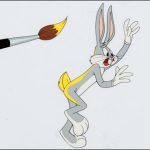

Cartoon consciousness comes in groups today, as we present a quartet of Tom and Jerrys and a duo of Bugs Bunny adventures, together with solo spots for the Road Runner, Lantz’s woodpeckers, and Paramount’s new team of Tommy Tortoise and Moe Hare.
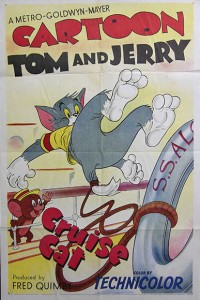 We begin with a couple of minor omissions from previous chapters, from the Tom and Jerry series. Cruise Cat (MGM, 10/18/52 – William Hanna/Joseph Barbera, dir.) fills for time, in the middle of a shipboard chase where Tom, the ship’s mascot, is pursuing Jerry aboard a cruise ship bound for Hawaii (a scenario which was notably something of a steal from a preceding Little Roquefort film from Terrytoons, “Seasick Sailors”, even borrowing a few gags from Terry). Our heroes round a corner into a doorway, and find themselves inside the ship’s onboard movie theater, which just happens to be starting a screening of their earlier episode, “Texas Tom”. The two each seem fully aware of their own screen careers, and pause in their chasing to enjoy the program. Two clops from the opening of the film are shown, the first with Tom getting the upper hand over Jerry. Tom laughs heartily at Jerry getting it on screen, while Jerry looks frustrated at Tom’s glee. But then, a second film clip shows Jerry evening the score with Tom. Jerry chortles uproariously at Tom’s downfall, while Tom’s anger builds at his humiliation on the silver screen, causing Tom to resume the shipboard pursuit, and attempt to toss Jerry overboard. Jerry ultimately falls down a ventilation funnel, into the ship’s kitchen, and right on top of the Captain’s dinner plate, spoiling Tom’s mousing record once again.
We begin with a couple of minor omissions from previous chapters, from the Tom and Jerry series. Cruise Cat (MGM, 10/18/52 – William Hanna/Joseph Barbera, dir.) fills for time, in the middle of a shipboard chase where Tom, the ship’s mascot, is pursuing Jerry aboard a cruise ship bound for Hawaii (a scenario which was notably something of a steal from a preceding Little Roquefort film from Terrytoons, “Seasick Sailors”, even borrowing a few gags from Terry). Our heroes round a corner into a doorway, and find themselves inside the ship’s onboard movie theater, which just happens to be starting a screening of their earlier episode, “Texas Tom”. The two each seem fully aware of their own screen careers, and pause in their chasing to enjoy the program. Two clops from the opening of the film are shown, the first with Tom getting the upper hand over Jerry. Tom laughs heartily at Jerry getting it on screen, while Jerry looks frustrated at Tom’s glee. But then, a second film clip shows Jerry evening the score with Tom. Jerry chortles uproariously at Tom’s downfall, while Tom’s anger builds at his humiliation on the silver screen, causing Tom to resume the shipboard pursuit, and attempt to toss Jerry overboard. Jerry ultimately falls down a ventilation funnel, into the ship’s kitchen, and right on top of the Captain’s dinner plate, spoiling Tom’s mousing record once again.
• Watch CRUISE CAT online by CLICKING HERE.
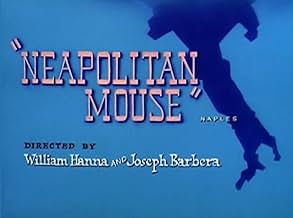 In Neapolitan Mouse (10/2/54), Tom and Jerry are once again on shipboard, but this time as international tourists, docking in Italy. The usual accidents and disagreements get the two chasing through the streets of Naples, where they encounter a small Italian mouse (an original character, not Tuffy), who doesn’t like big guys picking on little guys. He stops Tom’s pursuit in its tracks, but doesn’t play favorites, also bollixing up the efforts of a local dog to pick on Tom. Out heroes strike up a friendship with the little mouse, and agree for their time spent with him to act peaceably to one another. It turns out that the Italian mouse is the one aware of out heroes’ fame and the industry in which they work, as he begins to recognize the two that have befriended him. “Tom Cat? Jerry Mouse?…Ha, ha, ha, funny cartoons!” Eventually, the dog brings in two more canines for reinforcements, to gang up on the litte mouse, but Tom and Jerry return the mouse’s favor, by setting awhirl three large Italian cheeses, to pursue the dogs through the town like mini-steamrollers, and drive them off the docks.
In Neapolitan Mouse (10/2/54), Tom and Jerry are once again on shipboard, but this time as international tourists, docking in Italy. The usual accidents and disagreements get the two chasing through the streets of Naples, where they encounter a small Italian mouse (an original character, not Tuffy), who doesn’t like big guys picking on little guys. He stops Tom’s pursuit in its tracks, but doesn’t play favorites, also bollixing up the efforts of a local dog to pick on Tom. Out heroes strike up a friendship with the little mouse, and agree for their time spent with him to act peaceably to one another. It turns out that the Italian mouse is the one aware of out heroes’ fame and the industry in which they work, as he begins to recognize the two that have befriended him. “Tom Cat? Jerry Mouse?…Ha, ha, ha, funny cartoons!” Eventually, the dog brings in two more canines for reinforcements, to gang up on the litte mouse, but Tom and Jerry return the mouse’s favor, by setting awhirl three large Italian cheeses, to pursue the dogs through the town like mini-steamrollers, and drive them off the docks.
• Watch NEAPOLOTIAN MOUSE online by CLICKING HERE.
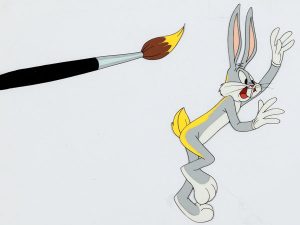 Rabbit Rampage (Warner, Bugs Bunny, 6/11/55 – Charles M. (Chuck) Jones, dir.) – Can lightning strike twice in the same place? Not very often. Still, Jones had had luck repeating a theme three times, in his trilogy of wars of words about hunting season between Bugs, Daffy, and Elmer comprised of “Rabbu Fire”, “Rabbit Seasoning”, and “Duck, Rabbit, Duck”. So, the thought that the formula of “Duck Amuck” could be repeated with success was perhaps not all that far-fetched – after all, it was already being used by other studios such as Terrytoons, as illustrated in last week’s article. Yet, there was a distinct difference in effect from casting Bugs Bunny rather than the Duck as the victim-to-be on the drawing paper. While Daffy was a master of hysteria, Bugs was a master of cool. While laughter can be easily generated from the frenetic angst arising from ill fortune befalling Daffy, it seems more inherently disturbing to watch calm and collected Bugs lose his cool in frustration. As funny as gag material may be, there is an entire switch of audience allegiance that results from this character miscasting. With Daffy, we rooted for the animator to throw some new stumbling block at the egotistical duck. With Bugs, we side with the rabbit, and actually want to see him figure some clever way to get out of this mess. This in a nutshell is why “Rabbit Rampage” fails to work om the same level as “Duck Amick”, generating only smiles and chuckles while the former film served up hearty doses of belly-laughs and guffaws. Perhaps Jones could have gotten better results by placing Wile E. Coyote on the drawing board, with the Road Runner as animator. But then, so much goes wrong in Wile E.’s life normally, that it wouldn’t really need the help of an animator’s brush to place the coyote knee-deep in disaster.
Rabbit Rampage (Warner, Bugs Bunny, 6/11/55 – Charles M. (Chuck) Jones, dir.) – Can lightning strike twice in the same place? Not very often. Still, Jones had had luck repeating a theme three times, in his trilogy of wars of words about hunting season between Bugs, Daffy, and Elmer comprised of “Rabbu Fire”, “Rabbit Seasoning”, and “Duck, Rabbit, Duck”. So, the thought that the formula of “Duck Amuck” could be repeated with success was perhaps not all that far-fetched – after all, it was already being used by other studios such as Terrytoons, as illustrated in last week’s article. Yet, there was a distinct difference in effect from casting Bugs Bunny rather than the Duck as the victim-to-be on the drawing paper. While Daffy was a master of hysteria, Bugs was a master of cool. While laughter can be easily generated from the frenetic angst arising from ill fortune befalling Daffy, it seems more inherently disturbing to watch calm and collected Bugs lose his cool in frustration. As funny as gag material may be, there is an entire switch of audience allegiance that results from this character miscasting. With Daffy, we rooted for the animator to throw some new stumbling block at the egotistical duck. With Bugs, we side with the rabbit, and actually want to see him figure some clever way to get out of this mess. This in a nutshell is why “Rabbit Rampage” fails to work om the same level as “Duck Amick”, generating only smiles and chuckles while the former film served up hearty doses of belly-laughs and guffaws. Perhaps Jones could have gotten better results by placing Wile E. Coyote on the drawing board, with the Road Runner as animator. But then, so much goes wrong in Wile E.’s life normally, that it wouldn’t really need the help of an animator’s brush to place the coyote knee-deep in disaster.
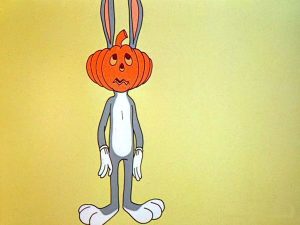 Cartoon Script #107 calls for an opening scene in the woodland, with rabbit hole in foreground, and Bugs coming out of hole to say, “What’s up, Doc?” Sounds typical enough – unless you draw the hole in the middle of the sky. A paintbrush does just that, leaving Bugs to take a dive, and deliver his line below on the ground while flat on his face. “Oh, you?”, says Bugs, instantly recognizing the unseen offscreen animator. “Well, if you’re the one that’s gonna draw this picture, then count me out”, says Bugs defiantly. He turns to dive into another rabbit hole properly upon the ground – until the eraser end of a pencil enters the shot, removing the hole from existence. Bugs smacks his head on the bare Earth. “I said I wasn’t working with you, and that is that”, declares Bugs, folding his arms and standing stock still. A paintbrush sneaks up behind Bugs, and paints a yellow streak up his back. Then, to make things hotter for Bugs with management, the brush begins to draw picket signs in Bugs’ hands, reading “I won’t work”, and “I refuse to live up to my contract.” Bugs reacts with shock at being caught with these signs, remarking how long he’s worked with the Warners to build up good will. “All right. You’ve made your point. You’re the boss. Just cut out the shenanigans, and I’ll go to work.” But the shenanigans don’t quit. Bugs suddenly finds himself in an equivalent position to Bartholemew Cubbins, with the brush drawing funny hats upon him. As fast as he removes one chapeau, another appears. A giant top hat that covers his entire upper torso is the limit. “Get yourself another boy”, grumbles Bugs, turning to walk away into the scenery, while still muttering, “What a Leonardo Da Punchy. What a Too-lousy Lautrec.”
Cartoon Script #107 calls for an opening scene in the woodland, with rabbit hole in foreground, and Bugs coming out of hole to say, “What’s up, Doc?” Sounds typical enough – unless you draw the hole in the middle of the sky. A paintbrush does just that, leaving Bugs to take a dive, and deliver his line below on the ground while flat on his face. “Oh, you?”, says Bugs, instantly recognizing the unseen offscreen animator. “Well, if you’re the one that’s gonna draw this picture, then count me out”, says Bugs defiantly. He turns to dive into another rabbit hole properly upon the ground – until the eraser end of a pencil enters the shot, removing the hole from existence. Bugs smacks his head on the bare Earth. “I said I wasn’t working with you, and that is that”, declares Bugs, folding his arms and standing stock still. A paintbrush sneaks up behind Bugs, and paints a yellow streak up his back. Then, to make things hotter for Bugs with management, the brush begins to draw picket signs in Bugs’ hands, reading “I won’t work”, and “I refuse to live up to my contract.” Bugs reacts with shock at being caught with these signs, remarking how long he’s worked with the Warners to build up good will. “All right. You’ve made your point. You’re the boss. Just cut out the shenanigans, and I’ll go to work.” But the shenanigans don’t quit. Bugs suddenly finds himself in an equivalent position to Bartholemew Cubbins, with the brush drawing funny hats upon him. As fast as he removes one chapeau, another appears. A giant top hat that covers his entire upper torso is the limit. “Get yourself another boy”, grumbles Bugs, turning to walk away into the scenery, while still muttering, “What a Leonardo Da Punchy. What a Too-lousy Lautrec.”
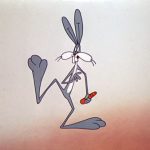 Bugs finds he can’t make a graceful exit, as the animator paints in the next background upside-down. Bugs finds himself walking on sky, with the ground above him. He clings to a tree trunk, and shimmies upwards, then swings over upon the stems of three flowers in the ground to a hole above. As Bugs clambers to climb up into the hole, the paintbrush again appears, drawing a string tied around Bugs’s tail, then a heavy anvil tied to the string. Bugs is pulled at full speed out of the hole, then crashes on a highway’s pavement hastily painted in far below. Bugs releases himself from the string, tumbling into an area of blank background. He begins swearing in nonsense syllables that sound like dialogue for Yosemite Sam, as the pencil eraser reappears, wiping away Bugs’s irate head. Bugs’s hands point to the void, insistently gesturing that his head be returned. The paintbrush draws in the head of a Jack O-Lantern. “Okay, buddy, you’ve had your fun. Now what about a rabbit’s head?” The brush merely draws two rabbit ears upon the pumpkin. “All right, you comic-book Rembrandt. Make with the eraser.” The pumpkin is erased, and Bugs’s head restored, in miniature. “Gad what a huge carrot”, says mini-Bugs at seeing the vegetable held in his hand. Bugs reaches to touch his head with his other hand, and finds he can clasp the whole thing in one palm. Bugs signals for another redraw, and gets his normal-sized head back, but with two omissions. “Ears?” He gets some he doesn’t approve. “Not human ears. Rabbit ears, long ones.” The brush provides two that extend a country mile. “Don’t be so danged literal!” The eraser restores them to normal length. Next, the eraser messes with Bugs’s posterior. “All right, you vandal. Put that tail back.” An appendage of the wrong kind is applied. “That is a horse’s tail. It belongs on a horse.” Eraser and brush join forces, converting Bugs completely into a horse. Bugs reminds that his contract clearly states he must always be drawn as a rabbit – so the brush draws him as a rabbit, but incredibly badly. “Continue drawing me like this, my friend, and we’ll both be outta work.”
Bugs finds he can’t make a graceful exit, as the animator paints in the next background upside-down. Bugs finds himself walking on sky, with the ground above him. He clings to a tree trunk, and shimmies upwards, then swings over upon the stems of three flowers in the ground to a hole above. As Bugs clambers to climb up into the hole, the paintbrush again appears, drawing a string tied around Bugs’s tail, then a heavy anvil tied to the string. Bugs is pulled at full speed out of the hole, then crashes on a highway’s pavement hastily painted in far below. Bugs releases himself from the string, tumbling into an area of blank background. He begins swearing in nonsense syllables that sound like dialogue for Yosemite Sam, as the pencil eraser reappears, wiping away Bugs’s irate head. Bugs’s hands point to the void, insistently gesturing that his head be returned. The paintbrush draws in the head of a Jack O-Lantern. “Okay, buddy, you’ve had your fun. Now what about a rabbit’s head?” The brush merely draws two rabbit ears upon the pumpkin. “All right, you comic-book Rembrandt. Make with the eraser.” The pumpkin is erased, and Bugs’s head restored, in miniature. “Gad what a huge carrot”, says mini-Bugs at seeing the vegetable held in his hand. Bugs reaches to touch his head with his other hand, and finds he can clasp the whole thing in one palm. Bugs signals for another redraw, and gets his normal-sized head back, but with two omissions. “Ears?” He gets some he doesn’t approve. “Not human ears. Rabbit ears, long ones.” The brush provides two that extend a country mile. “Don’t be so danged literal!” The eraser restores them to normal length. Next, the eraser messes with Bugs’s posterior. “All right, you vandal. Put that tail back.” An appendage of the wrong kind is applied. “That is a horse’s tail. It belongs on a horse.” Eraser and brush join forces, converting Bugs completely into a horse. Bugs reminds that his contract clearly states he must always be drawn as a rabbit – so the brush draws him as a rabbit, but incredibly badly. “Continue drawing me like this, my friend, and we’ll both be outta work.”
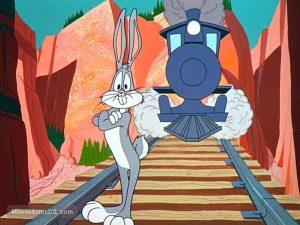 Bugs is returned to normal. “What a novel idea. Sure you wouldn’t want to make me into a grasshopper or somethin’?” The paintbrush enters the frame, armed with green paint. “No no no. I take it back!”, screams Bugs. Bugs suggests that he and the animator work together and perhaps create something revolutionary. Instead, the brush paints in two duplicates of Bugs. Bugs quickly disposes of the imposters, giving them the bum’s rush. Bugs demands the animator get the big boss in to see about these humiliations, and refuses to move from the spot until he does. The animator sees that Bugs moves, by drawing a railroad track under him, and an oncoming train emerging from a tunnel. Bugs leaps off the tracks in the nick of time, but still retains the last move. “There’s still one way out, and you can’t stop me.” “Bugs grabs at the top line of the film frame, and pulls down a card over the screen reading “The End.” The camera pulls back into the studio, revealing the artist behind the whole affair – Elmer Fudd. “Well anyway, I finawwy got even with that scwewy wabbit!”:
Bugs is returned to normal. “What a novel idea. Sure you wouldn’t want to make me into a grasshopper or somethin’?” The paintbrush enters the frame, armed with green paint. “No no no. I take it back!”, screams Bugs. Bugs suggests that he and the animator work together and perhaps create something revolutionary. Instead, the brush paints in two duplicates of Bugs. Bugs quickly disposes of the imposters, giving them the bum’s rush. Bugs demands the animator get the big boss in to see about these humiliations, and refuses to move from the spot until he does. The animator sees that Bugs moves, by drawing a railroad track under him, and an oncoming train emerging from a tunnel. Bugs leaps off the tracks in the nick of time, but still retains the last move. “There’s still one way out, and you can’t stop me.” “Bugs grabs at the top line of the film frame, and pulls down a card over the screen reading “The End.” The camera pulls back into the studio, revealing the artist behind the whole affair – Elmer Fudd. “Well anyway, I finawwy got even with that scwewy wabbit!”:
• Watch RABBIT RAMPAGE online by CLICKING HERE.
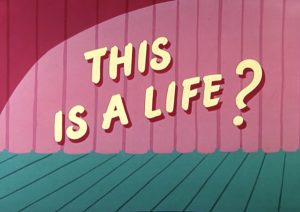 This Is a Life? (Warner, Bugs Bunny, 7/9/55 – (I. (Friz) Freleng, dir.), is essentially a cheater, but a well-done one with some entertaining new animation. It actually goes through a small degree of exorbitance right from the beginning, providing a new and slightly different orchestration of the traditional theme music, unique to this cartoon. The premise is a parody of Ralph Edwards’ popular TV show, “This Is Your Life”, where some well-known celebrity is surprised with a broadcast in his honor, telling his life story and rounding-up persons near and dear to him from his past. Elmer Fudd plays master of ceremonies in place of Edwards, and descends from the stage into an audience of celebrities, with a book inscribed with the name of the lucky star whose life story will be presented this evening. In the audience sit Bugs Bunny and Daffy Duck. Hearing Elmer’s utterances of glowing compliments as to tonight’s star’s beloved status in motion pictures, generous, charitable, and self-effacing, Daffy naturally assumes the referred-to celebrity can be none other than himself. “This would be embarrassing if it weren’t true”, says Daffy to Bugs. As Elmer approaches their aisle, Daffy leaps out of his seat to greet Fudd, and rushes Elmer to escort him to the stage. “Daffy Duck’s the name, as if it weren’t inscribed in gold on that little ol’ book, you master showman.” “Aren’t you Bugs Bunny?” asks Elmer, looking right past the eager duck. “Never mind him. We’ve only got a short time to do my interesting career”, protests Daffy, insisting that Elmer read the name on the book, good and loud. “BUGS BUNNY”, shouts Elmer. Daffy’s eyeballs bug out at the sight of the gold letters on the book cover.
This Is a Life? (Warner, Bugs Bunny, 7/9/55 – (I. (Friz) Freleng, dir.), is essentially a cheater, but a well-done one with some entertaining new animation. It actually goes through a small degree of exorbitance right from the beginning, providing a new and slightly different orchestration of the traditional theme music, unique to this cartoon. The premise is a parody of Ralph Edwards’ popular TV show, “This Is Your Life”, where some well-known celebrity is surprised with a broadcast in his honor, telling his life story and rounding-up persons near and dear to him from his past. Elmer Fudd plays master of ceremonies in place of Edwards, and descends from the stage into an audience of celebrities, with a book inscribed with the name of the lucky star whose life story will be presented this evening. In the audience sit Bugs Bunny and Daffy Duck. Hearing Elmer’s utterances of glowing compliments as to tonight’s star’s beloved status in motion pictures, generous, charitable, and self-effacing, Daffy naturally assumes the referred-to celebrity can be none other than himself. “This would be embarrassing if it weren’t true”, says Daffy to Bugs. As Elmer approaches their aisle, Daffy leaps out of his seat to greet Fudd, and rushes Elmer to escort him to the stage. “Daffy Duck’s the name, as if it weren’t inscribed in gold on that little ol’ book, you master showman.” “Aren’t you Bugs Bunny?” asks Elmer, looking right past the eager duck. “Never mind him. We’ve only got a short time to do my interesting career”, protests Daffy, insisting that Elmer read the name on the book, good and loud. “BUGS BUNNY”, shouts Elmer. Daffy’s eyeballs bug out at the sight of the gold letters on the book cover.
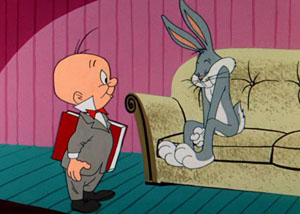 As Bugs is led to the stage in modest embarrassment, Daffy can’t hold in his verbal protests to anyone close enough to hear them – the closest being Granny in the next seat. Granny looks around for her umbrella, then bashes Daffy over the head with it, insisting that he pipe down so she can watch the program. Daffy continues to respond to Elmer’s plaudits of Bugs slightly more quietly, one remark from the stage prompting Daffy to hold his abdomen, and state to it, “Easy, stomach. Don’t turn over now.” Elmer asks Bugs to start recounting the past from the beginning. Bugs starts telling of the formation of Earth, and two tiny amoeba in a pool of water. “That’s TOO far back”, says Elmer, looking at his watch to keep track of the time they have left on the air. Bugs is prompted forward, with use of clips from “A Hare Grows in Manhattan” and “Hare Do”, then a guest appearance by a notable voice from Bugs’ past, turning out to be Yosemite Sam, who presents a clip from “Buccaneer Bunny”. As the clips unroll, Elmer and Sam get more irritated at remembering all the dirty tricks Bugs has pulled on them in the past, and Bugs starts to remind them of more, rubbing it in. Sam and Elmer rig up a time bomb inside a surprise package, and present it to Bugs. Bugs’ sensitive hearing picks up the ticking sound, and he modestly refuses the present, handing it back to Elmer. Startled, Elmer hands off the box to Sam, who hands it back to Elmer, then to Bugs. The three engage in a game of “hot potato” with the prize, while confused Daffy watches from the audience, not understanding why everyone is passing up on the goodies. Daffy suddenly rushes onto the stage, grabbing the package. “I’ll take it! After all, this should have been mine anyway.” Daffy walks into the theater wings, and we finally hear the expected “Ka-BOOM”. Daffy returns, bedraggled and with half his feathers blown off, long enough to utter his usual curtain line to Bugs: “You’re despicable.” Bugs gives the audience a look as if to say, “Yes, I know”, for the iris out.
As Bugs is led to the stage in modest embarrassment, Daffy can’t hold in his verbal protests to anyone close enough to hear them – the closest being Granny in the next seat. Granny looks around for her umbrella, then bashes Daffy over the head with it, insisting that he pipe down so she can watch the program. Daffy continues to respond to Elmer’s plaudits of Bugs slightly more quietly, one remark from the stage prompting Daffy to hold his abdomen, and state to it, “Easy, stomach. Don’t turn over now.” Elmer asks Bugs to start recounting the past from the beginning. Bugs starts telling of the formation of Earth, and two tiny amoeba in a pool of water. “That’s TOO far back”, says Elmer, looking at his watch to keep track of the time they have left on the air. Bugs is prompted forward, with use of clips from “A Hare Grows in Manhattan” and “Hare Do”, then a guest appearance by a notable voice from Bugs’ past, turning out to be Yosemite Sam, who presents a clip from “Buccaneer Bunny”. As the clips unroll, Elmer and Sam get more irritated at remembering all the dirty tricks Bugs has pulled on them in the past, and Bugs starts to remind them of more, rubbing it in. Sam and Elmer rig up a time bomb inside a surprise package, and present it to Bugs. Bugs’ sensitive hearing picks up the ticking sound, and he modestly refuses the present, handing it back to Elmer. Startled, Elmer hands off the box to Sam, who hands it back to Elmer, then to Bugs. The three engage in a game of “hot potato” with the prize, while confused Daffy watches from the audience, not understanding why everyone is passing up on the goodies. Daffy suddenly rushes onto the stage, grabbing the package. “I’ll take it! After all, this should have been mine anyway.” Daffy walks into the theater wings, and we finally hear the expected “Ka-BOOM”. Daffy returns, bedraggled and with half his feathers blown off, long enough to utter his usual curtain line to Bugs: “You’re despicable.” Bugs gives the audience a look as if to say, “Yes, I know”, for the iris out.
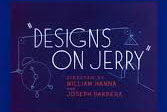 Designs on Jerry (MGM, Tom and Jerry, 9/2/55 – William Hanna/Joseph Barbera, dir.) – “Build a better mousetrap” has been the life goal of many an inventor – and Tom is no exception. He has whipped up a blueprint almost as wide as the room, depicting design for his original mousetrap, Reg. U.S. Pat. Off. But the feline Edison and Marconi rolled-into-one tires from his day’s labor, and decides to knock off and hit the hay.
Designs on Jerry (MGM, Tom and Jerry, 9/2/55 – William Hanna/Joseph Barbera, dir.) – “Build a better mousetrap” has been the life goal of many an inventor – and Tom is no exception. He has whipped up a blueprint almost as wide as the room, depicting design for his original mousetrap, Reg. U.S. Pat. Off. But the feline Edison and Marconi rolled-into-one tires from his day’s labor, and decides to knock off and hit the hay.
Mice have to stick together, and a stick-figure mouse drawn in mere outline of white ink on Tom’s blueprint senses that Tom’s design could mean real danger. The blueprint mouse comes to life as Tom dozes off, then grabs up Tom’s pen to draw a coiled line on the paper, using it as a rope to toss off the blueprint edge to the floor below, allowing him to slide down it to the ground. Outline Mouse then races into the hole of Jerry, also asleep in his own little bed. Jerry jas to rub his eyes in disbelief and wonderment at this strange little creature who awakens him, and only “talks” in violin-note squeaks, but insistently drags Jerry outside, hoisting him up to the blueprint with the line-rope. Outline Mouse begins pointing out the features of Tom’s device on the drawing. However, at one corner sits a drawing of an outline cat, with the inscription, “Cat listening for alarm.” The cat remains motionless as Jerry and Outline Mouse approach, then peers down menacingly at them, only a bite’s reach away from their faces. Jerry spots a rubber eraser and hands it to Outline Mouse, who proceeds to erase the cat’s lip line and teeth. The cat is forced to grab up the white ink pen, and sketch himself a new set of choppers. Outline Mouse, with another pen, draws Jerry a new mousehole on the blueprint to hide in. But the cat slams a paw down on Outline Mouse’s tail. As he attempts to run away, the mouse’s outline nearly unravels, with only his feet remaining in their original shape. Jerry employs a little fancy “footwork” too, borrowing a gag from Terrytoons’s Spoofy the Fox episode reviewed last week in these columns, by erasing the cat’s long hind legs, and replacing them with short, squatty ones. Temporarily unable to run fast, the cat converts the line of his tail into a lasso, roping Jerry by the tail.
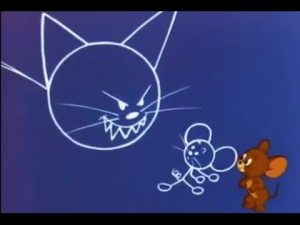 Before the cat can haul Jerry in, Outline Mouse draws himself a bow and arrow, and lets an arrow fly into the cat’s abdomen. When the cat pulls it out, his torso deflates like a balloon. Outline Mouse hides among an outline drawing of a potted tree and flowers, morphing his own outlines to resemble a posie. As the cat looks around for him in the opposite direction, Outline Mouse plucks the trunk of the potted plant from the pot, and uses its upper limbs like a fork, twirling its tines to roll the outlines of the cat up like a hefty mouthful of spaghetti. Jerry and Outline Mouse decide to leave the blueprint, leaping over the side, with Outline Mouse changing shape into a toy balloon to float them down to the ground. The cat restores his head to normal shape, but his body remains a mere elongated single outline – so he makes the most of it, slithering across the blueprint like a snake, then bouncing down off the drawing In the form of a coiled spring. But the mice are ready for him. Outline Mouse stands at the nozzle of a real-life seltzer bottle, and splashes the cat into a wall, converting most of him to a liquid puddle of ink. The cat’s head tries to rise, but Jerry pulls the old Fleischer “Out of the Inkwell” act upon him, sucking up all his ink into a fountain pen, then depositing it back into the bottle of white ink, as Outline Mouse plugs in the stopper. The two mice shake hands, but the job is not yet done, as Tom begins to awaken. The mice run back onto the blueprint. Jerry erases a number indicating a key distance between two objects, and Outline Mouse writes in a different one. Then Jerry returns to his home, while Outline Mouse returns to his original place on the blueprint, and becomes a mere motionless drawing again.
Before the cat can haul Jerry in, Outline Mouse draws himself a bow and arrow, and lets an arrow fly into the cat’s abdomen. When the cat pulls it out, his torso deflates like a balloon. Outline Mouse hides among an outline drawing of a potted tree and flowers, morphing his own outlines to resemble a posie. As the cat looks around for him in the opposite direction, Outline Mouse plucks the trunk of the potted plant from the pot, and uses its upper limbs like a fork, twirling its tines to roll the outlines of the cat up like a hefty mouthful of spaghetti. Jerry and Outline Mouse decide to leave the blueprint, leaping over the side, with Outline Mouse changing shape into a toy balloon to float them down to the ground. The cat restores his head to normal shape, but his body remains a mere elongated single outline – so he makes the most of it, slithering across the blueprint like a snake, then bouncing down off the drawing In the form of a coiled spring. But the mice are ready for him. Outline Mouse stands at the nozzle of a real-life seltzer bottle, and splashes the cat into a wall, converting most of him to a liquid puddle of ink. The cat’s head tries to rise, but Jerry pulls the old Fleischer “Out of the Inkwell” act upon him, sucking up all his ink into a fountain pen, then depositing it back into the bottle of white ink, as Outline Mouse plugs in the stopper. The two mice shake hands, but the job is not yet done, as Tom begins to awaken. The mice run back onto the blueprint. Jerry erases a number indicating a key distance between two objects, and Outline Mouse writes in a different one. Then Jerry returns to his home, while Outline Mouse returns to his original place on the blueprint, and becomes a mere motionless drawing again.
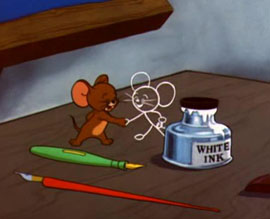 The cartoon feels like it’s run a bit short at this point – but it’s for a reason, as we’ve been set up for an extended grand finale. Tom goes to work constructing his masterpiece, which fills the entire attic with odds, ends, and devices of all sorts. It is an object of wonder Rube Goldberg would be proud of. Tom baits the device with cheese on the end of a string, outside Jerry’s mousehole, then waits behind a corner. Jerry, whom we know is aware that some sabotage has been effected, willingly takes the bait. The device merits description in the manner Goldberg might have provided in one of his comic drawings. Mouse A tugs at string B, which runs through pulley C to activate alarm clock D. Clapper of alarm bell is fastened to handle of saw E which saws off end of log F, which in turn falls upon scissors G, cutting rope H. Cut rope H runs through pulley I, releasing hammer J to fall on lever of high-striker K, launching banana L upwards to bell M. Banana innards are smashed, splashing onto auto windshield N, Automatic windshield wiper O is activated, with blade tied to jack handle P. Jack rises to tip suspended fire pail Q, depositing water R into bucket S on one end of scales of justice T. Other end of scale rises to switch on electric fan U, which blows toy sailboat V across tub of water W. Pool cue X fastened as bow to sailboat makes perfect shot on pool table Y, sending pool ball Z on a four-cushion bounce into button of electric switch AA placed in left corner pocket. (The pool table gag seems to have been remembered by toy designer Marvin Glass, creator of “Mouse Trap”, and was used in his own design for the lesser-known follow-up game, “Crazy Clock”.) Switch activates washing machine BB, whose wringer winds up string CC through pulley DD, pulling trigger of rifle EE. Bullet FF severs chain upon weight GG of cuckoo clock HH, activating clock hands II to the hour. Cuckoo bird JJ emerges on platform KK, to which is tied knife LL, which progressively cuts through rope MM, holding up suspended one-ton safe NN placed over Mouse A. Get the picture? Good. As the rope nears being cut through, Tom offers Jerry a blindfold and a last smoke, which Jerry boldly accepts, standing coolly in place. The rope snaps – but ahh, that key change of measurement effected by Outline Mouse. Down comes the safe – directly on Tom! Jerry casually scampers away, while Tom emerges from the safe, compressed into a cube, and utters swear words heard only as trombone honks on the track, for the iris out.
The cartoon feels like it’s run a bit short at this point – but it’s for a reason, as we’ve been set up for an extended grand finale. Tom goes to work constructing his masterpiece, which fills the entire attic with odds, ends, and devices of all sorts. It is an object of wonder Rube Goldberg would be proud of. Tom baits the device with cheese on the end of a string, outside Jerry’s mousehole, then waits behind a corner. Jerry, whom we know is aware that some sabotage has been effected, willingly takes the bait. The device merits description in the manner Goldberg might have provided in one of his comic drawings. Mouse A tugs at string B, which runs through pulley C to activate alarm clock D. Clapper of alarm bell is fastened to handle of saw E which saws off end of log F, which in turn falls upon scissors G, cutting rope H. Cut rope H runs through pulley I, releasing hammer J to fall on lever of high-striker K, launching banana L upwards to bell M. Banana innards are smashed, splashing onto auto windshield N, Automatic windshield wiper O is activated, with blade tied to jack handle P. Jack rises to tip suspended fire pail Q, depositing water R into bucket S on one end of scales of justice T. Other end of scale rises to switch on electric fan U, which blows toy sailboat V across tub of water W. Pool cue X fastened as bow to sailboat makes perfect shot on pool table Y, sending pool ball Z on a four-cushion bounce into button of electric switch AA placed in left corner pocket. (The pool table gag seems to have been remembered by toy designer Marvin Glass, creator of “Mouse Trap”, and was used in his own design for the lesser-known follow-up game, “Crazy Clock”.) Switch activates washing machine BB, whose wringer winds up string CC through pulley DD, pulling trigger of rifle EE. Bullet FF severs chain upon weight GG of cuckoo clock HH, activating clock hands II to the hour. Cuckoo bird JJ emerges on platform KK, to which is tied knife LL, which progressively cuts through rope MM, holding up suspended one-ton safe NN placed over Mouse A. Get the picture? Good. As the rope nears being cut through, Tom offers Jerry a blindfold and a last smoke, which Jerry boldly accepts, standing coolly in place. The rope snaps – but ahh, that key change of measurement effected by Outline Mouse. Down comes the safe – directly on Tom! Jerry casually scampers away, while Tom emerges from the safe, compressed into a cube, and utters swear words heard only as trombone honks on the track, for the iris out.
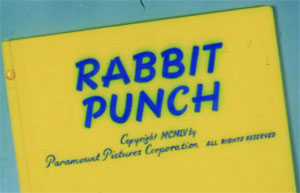 Rabbit Punch (Paramount/Famous, Tommy Tortoise and Moe Hare, 9/30/55 – Dave Tendlar, dir.) – Not to be confused with the Bugs Bunny title of the 1940’s reviewed in an earlier chapter of this series, though the subject is still the same – prize fighting. No doubt, as the Tommy Tortoise series was Paramount’s direct answer to Disney’s “The Tortoise and the Hare”, the thought to pair tortoise and hare in a boxing ring was a direct scenario lift from Disney’s only on-screen sequel, “Toby Tortoise Returns” (1936). However, Paramount sets the bout in a self-referential way, as the subject of a full written script resting on a table in a Hollywood animation studio. Scene 1 of script calls for a shot of a poster advertising the big fight, then a dissolve into the gymnasium. Moe Hare is all vim and vigor in jumping rope – even turning upside-down to jump by using his ears. Meanwhile, Tommy, also working out in the same gym, timidly taps at a suspended punching bag, ducking his head defensively into his shell every time the bag bobs back in his direction. Moe asks if he can work out on the device, too, and demonstrates some professional-looking rapid-fire jabs, following through with a final knockout blow, which he deliberately aims low to smack Tommy in the kisser. Tommy’s irises bounce back and forth within his eyeballs like a couple of loose marbles. Moe moves on to shadow boxing, while Tommy again timidly pokes at his own silhouette, cringing backwards after every love tap. The shadow of Moe moves in on the wall, and delivers an upper cut to Tommy’s shadow, knocking it cold upon the floor.
Rabbit Punch (Paramount/Famous, Tommy Tortoise and Moe Hare, 9/30/55 – Dave Tendlar, dir.) – Not to be confused with the Bugs Bunny title of the 1940’s reviewed in an earlier chapter of this series, though the subject is still the same – prize fighting. No doubt, as the Tommy Tortoise series was Paramount’s direct answer to Disney’s “The Tortoise and the Hare”, the thought to pair tortoise and hare in a boxing ring was a direct scenario lift from Disney’s only on-screen sequel, “Toby Tortoise Returns” (1936). However, Paramount sets the bout in a self-referential way, as the subject of a full written script resting on a table in a Hollywood animation studio. Scene 1 of script calls for a shot of a poster advertising the big fight, then a dissolve into the gymnasium. Moe Hare is all vim and vigor in jumping rope – even turning upside-down to jump by using his ears. Meanwhile, Tommy, also working out in the same gym, timidly taps at a suspended punching bag, ducking his head defensively into his shell every time the bag bobs back in his direction. Moe asks if he can work out on the device, too, and demonstrates some professional-looking rapid-fire jabs, following through with a final knockout blow, which he deliberately aims low to smack Tommy in the kisser. Tommy’s irises bounce back and forth within his eyeballs like a couple of loose marbles. Moe moves on to shadow boxing, while Tommy again timidly pokes at his own silhouette, cringing backwards after every love tap. The shadow of Moe moves in on the wall, and delivers an upper cut to Tommy’s shadow, knocking it cold upon the floor.
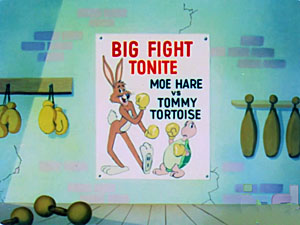 The night of the main event arrives. Tommy stumbles into the ring over the ropes, beginning the fight on his back. He pulls himself into the stool in his corner as the bell sounds. Moe begins with a reach so long, he socks Tommy in the jaw from all the way in the opposite corner. Moe stands Tommy up, bracing him in upright position by standing on Tommy’s feet, then whacks Tommy’s head around with a paddleball paddle. Tommy manages to retract his head into his shell, but Moe adopts the turban and flute of a snake charmer, playing music until Tommy’s head reflexively emerges in swaying fashion, then socking Tommy again. Soon, Moe has Tommy bounding off the four posts of the arena ropes, lighting up the tips of each pole like bumpers in a pinball machine. As the bell ending the first round sounds, Tommy is flat on his back again, with the word “Tilt” lighting up upon his chest. Tommy slowly hobbles back to his corner, but between rounds, his attention is aroused by an object offscreen. The camera pulls back, to reveal Tommy and the boxing ring upon a sheet of background paper on an animator’s desk, and the script we began the picture with in a bound volume on the next adjoining desk. Tommy hops of the paper, and over to the second desk to see just where this script is going. Opening the cover and flipping to a page covering the current state of the story, Tommy reads a list of forthcoming scenes. Rabbit hits turtle with chair. Rabbit hits turtle with kitchen sink. Rabbit knocks turtle’s head off. Rabbit bashes turtle to a pulp! Tommy has seen enough, and tells the audience, “If they think I’m gonna follow this script, they’re crazy!” Displaying amazing strength, Tommy picks up the bound volume, which is about five times larger than he is, and tears it in two like a strong man tearing a telephone book in half, then tosses both halves in a wastebasket.
The night of the main event arrives. Tommy stumbles into the ring over the ropes, beginning the fight on his back. He pulls himself into the stool in his corner as the bell sounds. Moe begins with a reach so long, he socks Tommy in the jaw from all the way in the opposite corner. Moe stands Tommy up, bracing him in upright position by standing on Tommy’s feet, then whacks Tommy’s head around with a paddleball paddle. Tommy manages to retract his head into his shell, but Moe adopts the turban and flute of a snake charmer, playing music until Tommy’s head reflexively emerges in swaying fashion, then socking Tommy again. Soon, Moe has Tommy bounding off the four posts of the arena ropes, lighting up the tips of each pole like bumpers in a pinball machine. As the bell ending the first round sounds, Tommy is flat on his back again, with the word “Tilt” lighting up upon his chest. Tommy slowly hobbles back to his corner, but between rounds, his attention is aroused by an object offscreen. The camera pulls back, to reveal Tommy and the boxing ring upon a sheet of background paper on an animator’s desk, and the script we began the picture with in a bound volume on the next adjoining desk. Tommy hops of the paper, and over to the second desk to see just where this script is going. Opening the cover and flipping to a page covering the current state of the story, Tommy reads a list of forthcoming scenes. Rabbit hits turtle with chair. Rabbit hits turtle with kitchen sink. Rabbit knocks turtle’s head off. Rabbit bashes turtle to a pulp! Tommy has seen enough, and tells the audience, “If they think I’m gonna follow this script, they’re crazy!” Displaying amazing strength, Tommy picks up the bound volume, which is about five times larger than he is, and tears it in two like a strong man tearing a telephone book in half, then tosses both halves in a wastebasket.
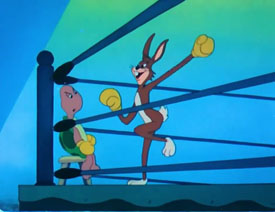 Tommy returns to the arena background for round 2. When the bell rings, Moe tries for a repeat of the same long-distance sock from the opposite side of the arena – only this time, Tommy ducks, letting the blows hit instead the metal pole behind Tommy in his corner. Tommy retracts his head and limbs into his shell, then rolls the shell on edge to the center of the ring. Moe starts throwing jabs as Tommy emerges, but Tommy synchronizes ducks of his head into his shell, to leave Moe merely swinging at air. Finally, something rises from the shell neck to meet Moe’s blow – a hard steel anvil. Moe’s fist bulges and throbs, beet red. Tommy leaps into the air, and again retracts head and limbs. All suddenly reappear, decked out in five boxing gloves. Tommy launches into an aerial spin, bombarding Moe’s face with a rapid-rotating quintuple punch. Moe is knocked into the ropes, and by the time he comes back to center of the ring, he finds not one, but three turtle shells greeting his eyes. The old shell game. Moe guesses wrong in choice of shells the first two times, but finally locates the one with a chest plate on the bottom. He lifts it to his eye to peer inside. Then Tommy flips the shell open from the top on a hinge, and emerges in underwear, carrying a large mallet. BONK! Moe is sent through the canvas. Below the ring, he spots something conveniently left behind from another bout, which is exactly what he needs. A pair of horseshoes, to load his gloves with. Tommy peers down through the hole in the canvas, and spots Moe’s treachery in the making. So when Moe climbs back into the ring, Tommy is ready for him. As Moe advances, with mouth briefly open, Tommy tosses a large horseshoe magnet down Moe’s throat. “Why you…”, shouts Moe, and launches a right hook at Tommy. A bolt of magnetic attraction fills the void between Moe’s glove and Moe’s belly, and his right hand is pulled away from Tommy’s face, landing instead with a metallic clank upon Moe’s midriff.
Tommy returns to the arena background for round 2. When the bell rings, Moe tries for a repeat of the same long-distance sock from the opposite side of the arena – only this time, Tommy ducks, letting the blows hit instead the metal pole behind Tommy in his corner. Tommy retracts his head and limbs into his shell, then rolls the shell on edge to the center of the ring. Moe starts throwing jabs as Tommy emerges, but Tommy synchronizes ducks of his head into his shell, to leave Moe merely swinging at air. Finally, something rises from the shell neck to meet Moe’s blow – a hard steel anvil. Moe’s fist bulges and throbs, beet red. Tommy leaps into the air, and again retracts head and limbs. All suddenly reappear, decked out in five boxing gloves. Tommy launches into an aerial spin, bombarding Moe’s face with a rapid-rotating quintuple punch. Moe is knocked into the ropes, and by the time he comes back to center of the ring, he finds not one, but three turtle shells greeting his eyes. The old shell game. Moe guesses wrong in choice of shells the first two times, but finally locates the one with a chest plate on the bottom. He lifts it to his eye to peer inside. Then Tommy flips the shell open from the top on a hinge, and emerges in underwear, carrying a large mallet. BONK! Moe is sent through the canvas. Below the ring, he spots something conveniently left behind from another bout, which is exactly what he needs. A pair of horseshoes, to load his gloves with. Tommy peers down through the hole in the canvas, and spots Moe’s treachery in the making. So when Moe climbs back into the ring, Tommy is ready for him. As Moe advances, with mouth briefly open, Tommy tosses a large horseshoe magnet down Moe’s throat. “Why you…”, shouts Moe, and launches a right hook at Tommy. A bolt of magnetic attraction fills the void between Moe’s glove and Moe’s belly, and his right hand is pulled away from Tommy’s face, landing instead with a metallic clank upon Moe’s midriff.
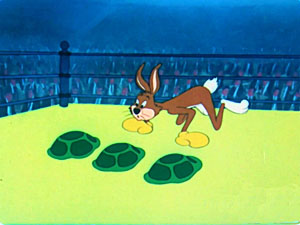 Moe tries again with his left, and has the same result repeated. As Moe desperately attempts to free his hands from his waistline, the magnet begins attracting more than just his gloves. The four corner posts of the ring all become uprooted at once, and smash into Moe’s torso simultaneously from all sides. Moe’s head slowly rises from between the poles, but the impact has forced the magnet into a new position – inside his ears, and pointed upwards. Another jolt of electrical attraction pulls down the ring’s heavy lighting fixture, right on top of Moe. Moe’s head slowly rises again through the top of the lighting fixture. One eye remains closed with a shiner, while the other reveals an eyeball in which, instead of an iris, is seen a count of numbers, rotating from 1 to 10. Before the final number is reached, the magnet’s attraction draws in one more object – the ringside bell, which clangs into Moe’s mouth just as the count in his eye reaches 10. As the bell sounds loudly against Moe’s jaw, both of his eyes open, revealing letters inside, reading “Yer out”. Tommy takes hold of the background drawing of the arena, rolls it up around Moe, and slides Moe off the animator’s desk into the wastebasket with the script. In a final shot, which has not yet been seen thanks to television removal of studio logos, Tommy reaches down for the corner of the screen frame, much like Tom the Cat at the end of “Johann Mouse”, presumably to flip a corner of the drawing upwards, and reveal an illustration behind Tommy’s plane of existence, of the Paramount mountain for the fade out.
Moe tries again with his left, and has the same result repeated. As Moe desperately attempts to free his hands from his waistline, the magnet begins attracting more than just his gloves. The four corner posts of the ring all become uprooted at once, and smash into Moe’s torso simultaneously from all sides. Moe’s head slowly rises from between the poles, but the impact has forced the magnet into a new position – inside his ears, and pointed upwards. Another jolt of electrical attraction pulls down the ring’s heavy lighting fixture, right on top of Moe. Moe’s head slowly rises again through the top of the lighting fixture. One eye remains closed with a shiner, while the other reveals an eyeball in which, instead of an iris, is seen a count of numbers, rotating from 1 to 10. Before the final number is reached, the magnet’s attraction draws in one more object – the ringside bell, which clangs into Moe’s mouth just as the count in his eye reaches 10. As the bell sounds loudly against Moe’s jaw, both of his eyes open, revealing letters inside, reading “Yer out”. Tommy takes hold of the background drawing of the arena, rolls it up around Moe, and slides Moe off the animator’s desk into the wastebasket with the script. In a final shot, which has not yet been seen thanks to television removal of studio logos, Tommy reaches down for the corner of the screen frame, much like Tom the Cat at the end of “Johann Mouse”, presumably to flip a corner of the drawing upwards, and reveal an illustration behind Tommy’s plane of existence, of the Paramount mountain for the fade out.
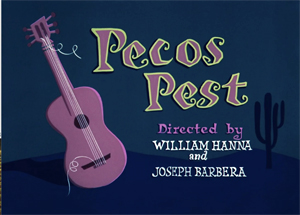 Compared to Designs on Jerry, Pecos Pest (MGM, Tom and Jerry, 11/11/55 – William Hanna/Joseph Barbera, dir.) is a startlingly simple, one-joke premise. Yet, its presentation, timing, and voicing create a memorable character and a highly enjoyable episode, with a great payoff. Jerry’s Texas uncle, Pecos, comes a-visitin’, spending the night while in town to make his television debut, performing a comic version of “Froggy Went a-Courtin” on guitar. Pecos, a mouse in a Stetson hat and with long gray moustache parted in the middle, is voiced by veteran Western singer Shug Fisher, who was performing his act in night clubs when spotted by one or both of the directors, and asked to incorporate his routine into the film. During a run-through of his number for Jerry, a string of Pecos’s guitar suddenly snaps. Jerry has no substitute guitar strings handy, but Pecos decares, “I see one”, looking out the mousehole and eyeing the fine facial whiskers of the sleeping Tom. Pecos rudely marches out, and plucks a whisker right off of Tom’s face, hollering “Thank ya’, pardner! Can’t sing without a string.” This becomes rather a habit, as Pecos’s roughshod playing continues to take a toll upon his musical instrument, with one after another of its strings snapping. Pecos is unstoppable in his determination to keep playing, smashing through doors, flipping over chairs, leaving Tom always the victim for more strings. Even a helmet from a suit of armor can’t shield Tom’s whiskers, and Tom surrenders his fifth of six whiskers under a flag of truce, to avoid having Pecos chop through a door with an axe. Pecos finally leaves for the TV studio, and Jerry, along with a disgruntled Tom, watch the evening broadcast. Pecos makes his entrance on the screen, and barely gets his musical intro started, when a string breaks again. In the living room, Tom lets out with what is perhaps the most heartfelt evil horselaugh ever uttered by him throughout the entire series – only to have his glee abruptly silenced by the savvy Pecos, reaching out through the TV screen to pluck away Tom’s last whisker, and finish his number for the iris out..
Compared to Designs on Jerry, Pecos Pest (MGM, Tom and Jerry, 11/11/55 – William Hanna/Joseph Barbera, dir.) is a startlingly simple, one-joke premise. Yet, its presentation, timing, and voicing create a memorable character and a highly enjoyable episode, with a great payoff. Jerry’s Texas uncle, Pecos, comes a-visitin’, spending the night while in town to make his television debut, performing a comic version of “Froggy Went a-Courtin” on guitar. Pecos, a mouse in a Stetson hat and with long gray moustache parted in the middle, is voiced by veteran Western singer Shug Fisher, who was performing his act in night clubs when spotted by one or both of the directors, and asked to incorporate his routine into the film. During a run-through of his number for Jerry, a string of Pecos’s guitar suddenly snaps. Jerry has no substitute guitar strings handy, but Pecos decares, “I see one”, looking out the mousehole and eyeing the fine facial whiskers of the sleeping Tom. Pecos rudely marches out, and plucks a whisker right off of Tom’s face, hollering “Thank ya’, pardner! Can’t sing without a string.” This becomes rather a habit, as Pecos’s roughshod playing continues to take a toll upon his musical instrument, with one after another of its strings snapping. Pecos is unstoppable in his determination to keep playing, smashing through doors, flipping over chairs, leaving Tom always the victim for more strings. Even a helmet from a suit of armor can’t shield Tom’s whiskers, and Tom surrenders his fifth of six whiskers under a flag of truce, to avoid having Pecos chop through a door with an axe. Pecos finally leaves for the TV studio, and Jerry, along with a disgruntled Tom, watch the evening broadcast. Pecos makes his entrance on the screen, and barely gets his musical intro started, when a string breaks again. In the living room, Tom lets out with what is perhaps the most heartfelt evil horselaugh ever uttered by him throughout the entire series – only to have his glee abruptly silenced by the savvy Pecos, reaching out through the TV screen to pluck away Tom’s last whisker, and finish his number for the iris out..
• Watch PECOS PEST online by CLICKING HERE.
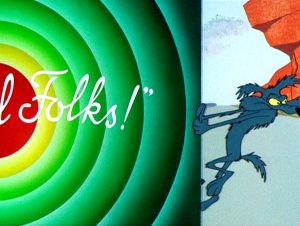 Guided Muscle (Warner, Road Runner, 12/10/55 – Charles M. (Chuck) Jones, dir,) – Another typical day in the desert, and another chase between Wile E. Coyote and the Road Runner. This time, however, Beep Beep does not have the final say. For perhaps the first time, Wile E. interacts directly with the audience. After a day full of endless short blackout gags, including backfiring bow and arrow, giant slingshot, cannot, wrecking ball, and even a tar and feather machine, Wile E. is blown up by pursuing the road runner across the coyote’s own subterranean booby trap of a buried stash of dynamite. The coyote freezes in charred state above the point of explosion, then steps down to the ground and exits the shot, only to return to plant a large sign at screen center for the audience to read. “Wanted – one gullible coyote. Apply to manager of this theater.” Wile E. then exits the frame again, once again returning to drag in across the screen the “That’s All Folks” end card, already in progress.
Guided Muscle (Warner, Road Runner, 12/10/55 – Charles M. (Chuck) Jones, dir,) – Another typical day in the desert, and another chase between Wile E. Coyote and the Road Runner. This time, however, Beep Beep does not have the final say. For perhaps the first time, Wile E. interacts directly with the audience. After a day full of endless short blackout gags, including backfiring bow and arrow, giant slingshot, cannot, wrecking ball, and even a tar and feather machine, Wile E. is blown up by pursuing the road runner across the coyote’s own subterranean booby trap of a buried stash of dynamite. The coyote freezes in charred state above the point of explosion, then steps down to the ground and exits the shot, only to return to plant a large sign at screen center for the audience to read. “Wanted – one gullible coyote. Apply to manager of this theater.” Wile E. then exits the frame again, once again returning to drag in across the screen the “That’s All Folks” end card, already in progress.
• Watch GUIDED MUSCLE online by CLICKING HERE.
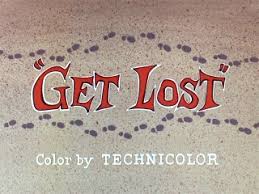 Get Lost (Lantz/Universal, Knothead and Splinter, 3/12/56 – Paul J. Smith, dir.) – Woody Woodpecker is attempting to tell his nephew and niece the story of Hansel and Gretel. The two kids, small enough to be concealed behind the cover of Woody’s open storybook, tire of the tale, and figure it’d be more fun to try it themselves, by walking blindfolded into the woods and letting themselves get lost. However, their little game does not go unnoticed by a local cat, a charter member of the Cat’s Eye Bird Watching Society – but for reasons of appetite rather than aesthetics. Add water and stir within a large box labeled “Ready Mix Gingerbread House’, and an appealing candy-coated cottage arises, complete with a large rectangular gingerbread cake baking in the oven, suitable for use at the front door, and ready to add icing to reading “Welcome”. The kids know this is hokum, but Knothead, for the sake of progressing the story, states, “We can go along with it.”
Get Lost (Lantz/Universal, Knothead and Splinter, 3/12/56 – Paul J. Smith, dir.) – Woody Woodpecker is attempting to tell his nephew and niece the story of Hansel and Gretel. The two kids, small enough to be concealed behind the cover of Woody’s open storybook, tire of the tale, and figure it’d be more fun to try it themselves, by walking blindfolded into the woods and letting themselves get lost. However, their little game does not go unnoticed by a local cat, a charter member of the Cat’s Eye Bird Watching Society – but for reasons of appetite rather than aesthetics. Add water and stir within a large box labeled “Ready Mix Gingerbread House’, and an appealing candy-coated cottage arises, complete with a large rectangular gingerbread cake baking in the oven, suitable for use at the front door, and ready to add icing to reading “Welcome”. The kids know this is hokum, but Knothead, for the sake of progressing the story, states, “We can go along with it.”
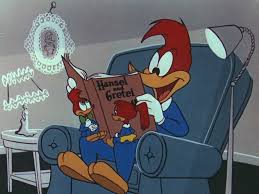 “Hansel” and “Gretel” are renamed by the cat “lunch” and “dinner”. Knothead won’t stay caged, pecking a key out of his birdcage perch to achieve escape. The kids wind up in a pie in the oven, but manage to drag a telephone in with them. Placing a quick call to the gas company, they state that they refuse to pay their bill – causing the gas to be immediately shut off. Various violent and explosive pranks are played upon the cat, climaxed by offering him a bowl of soup as a substitute dish. “How about a cracker?”, asks the cat. Knothead approaches the camera, carrying what appears to be a round cracker in a face-on view. He rounds a corner, revealing that the round circle we have seen is merely the top end of a mile-long firecracker, the back end of which is being carried by Splinter. The outer casing of the firecracker cylinder bears the inscription, “You can’t hardly get them this size no more.” The firecracker is tossed into the cat’s hands. But the camera doesn’t stick around to see the outcome. Instead, we witness shots of Knothead and Splinter escaping the gingerbread house, returning to Woody’s abode, and taking their original places upon Woody’s knees, as Woody concludes his reading of the tale of Hansel and Gretel. The camera pulls back into a cartoon depiction of the local movie theater, where Woody and the kids are still seen in the easy chair upon the theater screen. A man stands up from one of the audience back rows, and shouts to the trio, “Hey, what about the last firecracker?” Woody and the kids, still on the screen, point to stage right, and the camera view pans, returning us to view of the cat, still holding the firecracker, just long enough for us to witness the shot becoming obliterated by the smoke cloud from the firecracker’s explosion, and for the fade out.
“Hansel” and “Gretel” are renamed by the cat “lunch” and “dinner”. Knothead won’t stay caged, pecking a key out of his birdcage perch to achieve escape. The kids wind up in a pie in the oven, but manage to drag a telephone in with them. Placing a quick call to the gas company, they state that they refuse to pay their bill – causing the gas to be immediately shut off. Various violent and explosive pranks are played upon the cat, climaxed by offering him a bowl of soup as a substitute dish. “How about a cracker?”, asks the cat. Knothead approaches the camera, carrying what appears to be a round cracker in a face-on view. He rounds a corner, revealing that the round circle we have seen is merely the top end of a mile-long firecracker, the back end of which is being carried by Splinter. The outer casing of the firecracker cylinder bears the inscription, “You can’t hardly get them this size no more.” The firecracker is tossed into the cat’s hands. But the camera doesn’t stick around to see the outcome. Instead, we witness shots of Knothead and Splinter escaping the gingerbread house, returning to Woody’s abode, and taking their original places upon Woody’s knees, as Woody concludes his reading of the tale of Hansel and Gretel. The camera pulls back into a cartoon depiction of the local movie theater, where Woody and the kids are still seen in the easy chair upon the theater screen. A man stands up from one of the audience back rows, and shouts to the trio, “Hey, what about the last firecracker?” Woody and the kids, still on the screen, point to stage right, and the camera view pans, returning us to view of the cat, still holding the firecracker, just long enough for us to witness the shot becoming obliterated by the smoke cloud from the firecracker’s explosion, and for the fade out.
NEXT TIME: Another broad spectrum of 50’s theatricals.